AOAC 官方方法999.03 食品中总果聚糖的测定中文翻译
- 格式:docx
- 大小:35.61 KB
- 文档页数:4
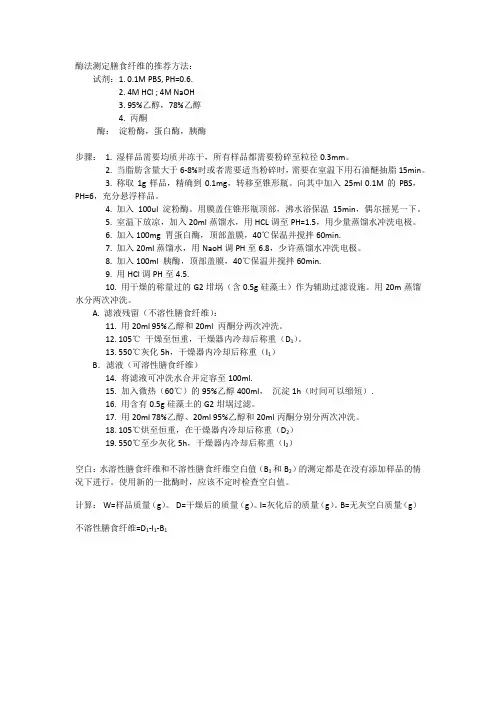
酶法测定膳食纤维的推荐方法:试剂:1. 0.1M PBS, PH=0.6.2. 4M HCl ; 4M NaOH3. 95%乙醇,78%乙醇4. 丙酮酶:淀粉酶,蛋白酶,胰酶步骤:1. 湿样品需要均质并冻干,所有样品都需要粉碎至粒径0.3mm。
2. 当脂肪含量大于6-8%时或者需要适当粉碎时,需要在室温下用石油醚抽脂15min。
3. 称取1g样品,精确到0.1mg,转移至锥形瓶。
向其中加入25ml 0.1M的PBS,PH=6,充分悬浮样品。
4. 加入100ul 淀粉酶。
用膜盖住锥形瓶顶部,沸水浴保温15min,偶尔摇晃一下。
5. 室温下放凉,加入20ml蒸馏水,用HCL调至PH=1.5,用少量蒸馏水冲洗电极。
6. 加入100mg 胃蛋白酶,顶部盖膜,40℃保温并搅拌60min.7. 加入20ml蒸馏水,用NaoH调PH至6.8,少许蒸馏水冲洗电极。
8. 加入100ml 胰酶,顶部盖膜,40℃保温并搅拌60min.9. 用HCl调PH至4.5.10. 用干燥的称量过的G2坩埚(含0.5g硅藻土)作为辅助过滤设施。
用20m蒸馏水分两次冲洗。
A. 滤液残留(不溶性膳食纤维):11. 用20ml 95%乙醇和20ml 丙酮分两次冲洗。
12. 105℃干燥至恒重,干燥器内冷却后称重(D1)。
13. 550℃灰化5h,干燥器内冷却后称重(I1)B.滤液(可溶性膳食纤维)14. 将滤液可冲洗水合并定容至100ml.15. 加入微热(60℃)的95%乙醇400ml,沉淀1h(时间可以缩短).16. 用含有0.5g硅藻土的G2坩埚过滤。
17. 用20ml 78%乙醇、20ml 95%乙醇和20ml丙酮分别分两次冲洗。
18. 105℃烘至恒重,在干燥器内冷却后称重(D2)19. 550℃至少灰化5h,干燥器内冷却后称重(I2)空白:水溶性膳食纤维和不溶性膳食纤维空白值(B1和B2)的测定都是在没有添加样品的情况下进行。

第52卷分析化学(FENXI HUAXUE)评述与进展第3期2024年3月Chinese Journal of Analytical Chemistry297~305DOI:10.19756/j.issn.0253-3820.231215评述与进展低聚果糖定量检测方法的研究进展柳玉蓉1,2李秀琴2陈智*1周霞*2张庆合*21(中国计量大学材料与化学学院,杭州310018)2(中国计量科学研究院化学计量与分析科学研究所,北京100029)摘要低聚果糖(Fructooligosaccharide,FOS)具有调节肠道菌群、降低血糖等多种生理功能,作为一种功能性低聚糖广泛应用于食品和营养领域,常作为营养强化剂添加到婴幼儿配方食品及婴幼儿谷类辅助食品中。
近年来,用于植物和食品中FOS分离分析的技术得到了快速发展,然而FOS的结构和组成多样性对其准确定量检测提出了挑战。
建立FOS的准确定量检测方法对于提升FOS的质量、功效研究和相关食品质量的监管尤为必要。
本文综述了近年来FOS定量检测方法的研究进展,对当前FOS定量检测方法存在的问题和面临的挑战进行了分析,并展望了其未来的发展方向。
关键词低聚果糖;益生元;膳食纤维;定量检测;食品基质;一测多评;评述低聚果糖(Fructooligosaccharide,FOS)是由2~10个单糖通过糖苷键形成的直链或支链聚合糖,是一种功能性低聚糖,被归类为益生元和可溶性膳食纤维。
根据来源和糖单元之间连接键型,FOS主要分为三大类型:菊粉型、Levan型和混合型。
菊粉型FOS中果糖基之间为β(2→1)连接键,主要以菊粉为原料生产,菊粉经内切酶或外切酶酶解生成FOS,使用菊粉内切酶产生的FOS包括蔗果型FOS(GF n)和果果型FOS(FF n)[1];使用菊粉外切酶产生的FOS只有GF n型。
另外,以蔗糖为底物,在果糖基转移酶作用下生产得到的FOS也为GF n型,GF n型的末端通过α(1→2)键连接D-吡喃葡萄糖单元[2]。
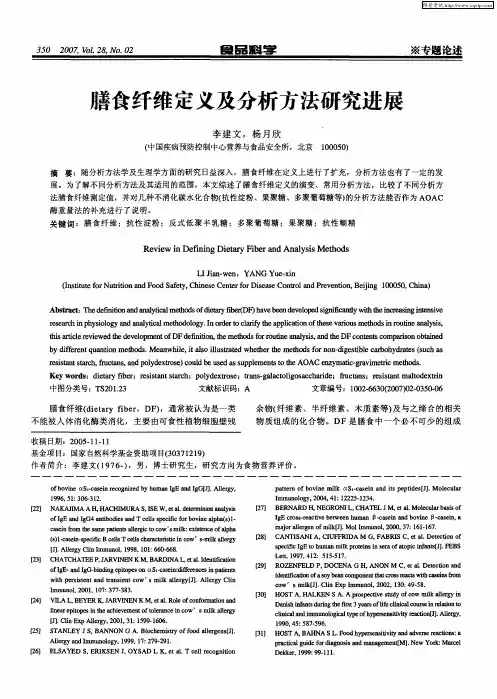

17.2.09AOAC官方方法 997.02食品中酵母菌和霉菌的计数再水化干膜法(Petrifilm TM法)首次发布 1997最终发布 2000(适用于食品中酵母菌和霉菌总数的计数)表格997.02A和B为验证并采纳此方法的多个实验室的研究结果。
A. 原理本方法使用的测试片含有抗生素和指示剂以增强对菌落生长的指示作用,还含有冷水可溶性凝胶。
在每张测试片上添加1ml的未经稀释或稀释过的样品均液。
将样品均液分布在大约为30cm2的生长区域中。
将胶凝剂固化,将测试片进行培养,并计算酵母菌和霉菌的数量。
B. 仪器和试剂(a)酵母菌和霉菌测试片—培养基中添加了:氯四环素、氯霉素、冷水可溶性凝胶和对磷酸盐(5-溴-4-氯-3吲哚基-磷酸盐)敏感的指示剂,该指示剂用于增强对酵母菌和霉菌的生长的指示作用。
一个测试片的圆形生长区域中包含了30个在测试片上的1cm×1cm的方格(可以使用3M TM Petrifilm TM酵母菌和霉菌测试片,3M Microbiology Products,3M Center, bldg. 275-5W-05, St. Paul, MN 55144-1000, USA)。
(b) 塑料压板-与Petrifilm测试片一起提供,用于将样品均液均匀地扩散在测试片上的生长区域。
(c) 移液管-能精确移取1.0ml的移液管或者注射器。
(d) 菌落计数器-标准设备,最好是Quebec型,或者是能够提供同等放大率(×1.5)和可见度的设备。
(e) 搅拌器-转速为10000-12000rpm的机械搅拌器或者stomacher拍击式均质器。
(f) 稀释液-Butterfield磷酸盐缓冲稀释用水。
将34g KH2PO4加入1L容量瓶中,并用500ml水稀释。
用1M 的NaOH溶液(40g/L)调整pH值至7.2,并用水稀释至1L。
在121℃下高压灭菌处理15分钟。
将原液储存于冰箱之中。
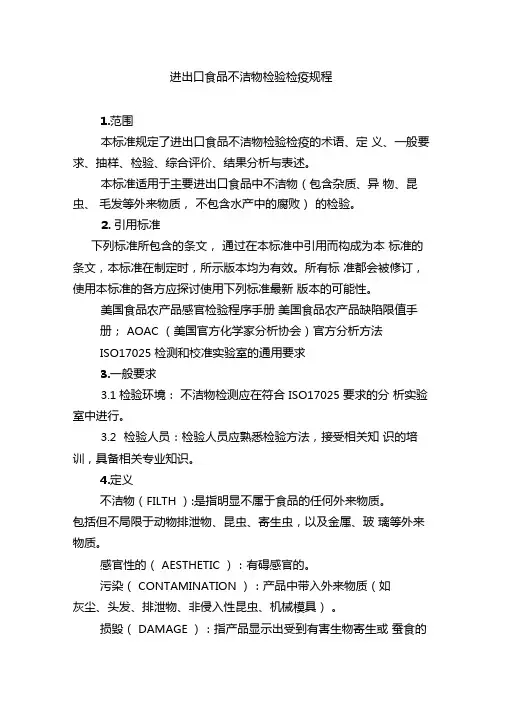
进出口食品不洁物检验检疫规程1.范围本标准规定了进出口食品不洁物检验检疫的术语、定义、一般要求、抽样、检验、综合评价、结果分析与表述。
本标准适用于主要进出口食品中不洁物(包含杂质、异物、昆虫、毛发等外来物质,不包含水产中的腐败)的检验。
2. 引用标准下列标准所包含的条文,通过在本标准中引用而构成为本标准的条文,本标准在制定时,所示版本均为有效。
所有标准都会被修订,使用本标准的各方应探讨使用下列标准最新版本的可能性。
美国食品农产品感官检验程序手册美国食品农产品缺陷限值手册;AOAC (美国官方化学家分析协会)官方分析方法ISO17025 检测和校准实验室的通用要求3.一般要求3.1检验环境:不洁物检测应在符合ISO17025 要求的分析实验室中进行。
3.2检验人员:检验人员应熟悉检验方法,接受相关知识的培训,具备相关专业知识。
4.定义不洁物(FILTH ):是指明显不属于食品的任何外来物质。
包括但不局限于动物排泄物、昆虫、寄生虫,以及金属、玻璃等外来物质。
感官性的(AESTHETIC ):有碍感官的。
污染(CONTAMINATION ):产品中带入外来物质(如灰尘、头发、排泄物、非侵入性昆虫、机械模具)。
损毁(DAMAGE ):指产品显示出受到有害生物寄生或蚕食的迹象(如虫道、咬痕、卵鞘等)。
腐败(DECOMPOSED ):细菌分解正常产品组织及后续酶类导致的化学变化。
这些变化以异常气味、口感、质地、色泽等表现出来。
经济掺假(ECONOMIC ADULTERATION ):指蓄意不去除终产品中的不可食用物质或者蓄意在产品中添加或替换成本较低的食品或成分。
异物(EXTRANEOUS MATERIALS ):指与产品生产、储存或流通过程的不良条件或操作相关的产品中的任何外来物质。
包括:昆虫、鼠类、鸟类等带来的令人不快的物质;降解物质;及沙子、土壤、玻璃、铁锈等或其它外来物质等杂物。
外来物质(FOREIGN MATTER ):包括如树枝、石头、麻袋纤维、烟头等令人不快的物质,也包括原料植物的无价值部分,如茎。
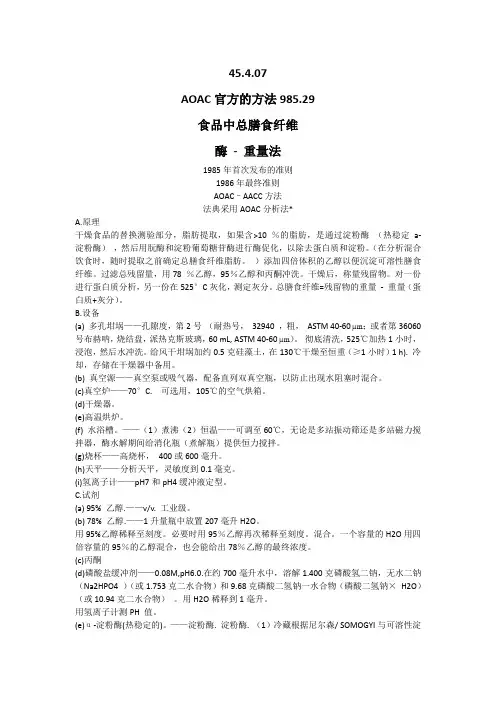
45.4.07AOAC官方的方法985.29食品中总膳食纤维酶- 重量法1985年首次发布的准则1986年最终准则AOAC–AACC方法法典采用AOAC分析法*A.原理干燥食品的替换测验部分,脂肪提取,如果含>10 %的脂肪,是通过淀粉酶(热稳定a-淀粉酶),然后用朊酶和淀粉葡萄糖苷酶进行酶促化,以除去蛋白质和淀粉。
(在分析混合饮食时,随时提取之前确定总膳食纤维脂肪。
)添加四倍体积的乙醇以便沉淀可溶性膳食纤维。
过滤总残留量,用78 %乙醇,95%乙醇和丙酮冲洗。
干燥后,称量残留物。
对一份进行蛋白质分析,另一份在525°C灰化,测定灰分。
总膳食纤维=残留物的重量- 重量(蛋白质+灰分)。
B.设备(a) 多孔坩埚——孔隙度,第2号(耐热号,32940 ,粗,ASTM 40-60 μm;或者第36060号布赫呐,烧结盘,派热克斯玻璃,60 mL, ASTM 40-60 μm)。
彻底清洗,525℃加热1小时,浸泡,然后水冲洗。
给风干坩埚加约0.5克硅藻土,在130℃干燥至恒重(≥1小时)1 h). 冷却,存储在干燥器中备用。
(b) 真空源——真空泵或吸气器,配备直列双真空瓶,以防止出现水阻塞时混合。
(c)真空炉——70°C. 可选用,105℃的空气烘箱。
(d)干燥器。
(e)高温烘炉。
(f) 水浴槽。
——(1)煮沸(2)恒温——可调至60℃,无论是多站振动筛还是多站磁力搅拌器,酶水解期间给消化瓶(煮解瓶)提供恒力搅拌。
(g)烧杯——高烧杯,400或600毫升。
(h)天平——分析天平,灵敏度到0.1毫克。
(i)氢离子计——pH7和pH4缓冲液定型。
C.试剂(a) 95% 乙醇.——v/v. 工业级。
(b) 78% 乙醇.——1升量瓶中放置207毫升H2O。
用95%乙醇稀释至刻度。
必要时用95%乙醇再次稀释至刻度。
混合。
一个容量的H2O用四倍容量的95%的乙醇混合,也会能给出78%乙醇的最终浓度。
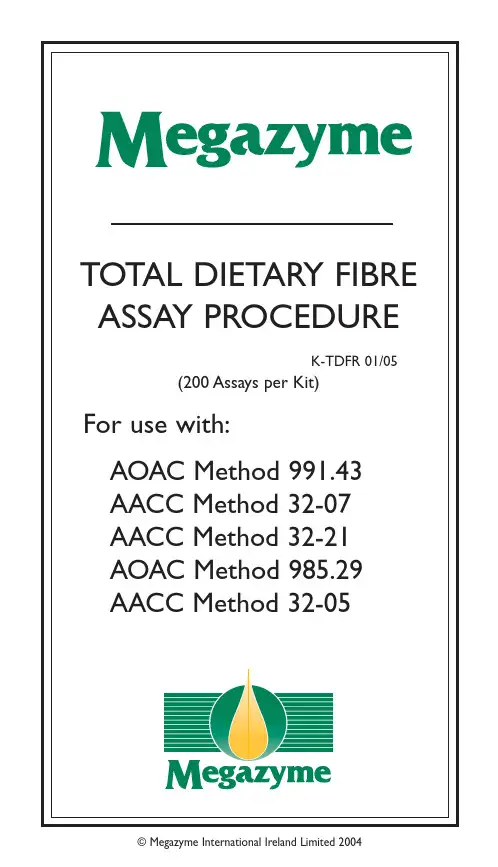
INTRODUCTION:Dietary fibre is a mixture of complex organic substances including, non-swellable,more or less hydrophobic compounds such as cutins, suberins and lignins;as well as a range of hydrophilic compounds such as soluble and insoluble polysaccharides and non digestable oligosaccharides.The procedures for the determination of total dietary fibre as outlined in this booklet are based on the methods of Lee et al.1and Prosky et al.2,3(AOAC 991.43,AOAC 985.29,AACC 32-07 and AACC 32-05).However,the enzymes in the MegazymeT otal Dietary Fibre Kit can also be used in other dietary fibre analytical methods such as AACC Method 32-21 and AACC method 32-06.PRINCIPLE (TOTAL DIETARY FIBRE):T otal dietary fibre (TDF) is determined on duplicate samples of dried and defatted (if fat content is >10%) material.Samples are cooked at ~100°C with heat stable α-amylase to give gelatinisation,hydrolysis and depolymerisation of starch;incubated at 60°C with protease (to solubilise and depolymerise proteins) and amyloglucosidase (to hydrolyse starch fragments to glucose);and treated with four volumes of ethanol to precipitate soluble fibre and remove depolymerised protein and glucose (from starch).The residue is filtered;washed with 78% ethanol,95% ethanol,and acetone;dried;and weighed.One duplicate is analysed for protein and the other is incubated at 525°C to determine ash.The TDF is the weight of the filtered and dried residue less the weight of the protein and ash.The major advantage of the Megazyme TDF T est Kit is that it contains high purity enzymes devoid of interfering activities,and the activities of the enzymes are standardised.The importance of standardisedα-amylase activity in the measurement of resistant starch is well recognised.Megazyme amyloglucosidase is essentially devoid of cellulase,whereas other commonly used preparations contain significant contamination with this activity,which leads to solubilisation and underestimation of β-glucan.All Megazyme TDF enzymes are supplied in a ready-to-use,stabilised,liquid form. SCOPE:Applicable to cereal grains,fruit and vegetables,cereal and fruit products and foods.ENZYME PURITY AND STANDARDISATION:The effectiveness and purity of Megazyme α-amylase,protease and amyloglucosidase have been evaluated using the standards recommended in AOAC Method 985.29 and 991.43,and AACC Method 32-05.Megazyme thermostable α-amylase (E-BLAAM) has an activity of 3,000 U/mL (Ceralpha method);protease is supplied at aAPPARATUS:1.Beakers,400 mL and 600 mL tall-form.2.Fritted crucible,Corning No.36060 Büchner,fritted disk,Pyrex60mL,pore size,coarse,ASTM 40-60 µm,or equivalent.Prepare as follows:a.Ash overnight at 525°C in muffle furnaceb.Remove Celite and ash material by using a vacuumc.Soak in 2% Micro cleaning solution (reagent 7) at roomtemperature for 1 hr.d.Rinse crucibles with water and deionised water.e.For final rinse,use 15 mL acetone and air dry.f.Add approximately 1.0 g Celite to dried crucibles and dry at130°C to constant weight.g.Cool crucible in desiccator for approximately 1 hr andrecord weight of crucible containing Celite.3.Filtering flask,heavy-walled,with 1-L side arm.4.Rubber ring adaptors for use on filtering flasks.5.Vacuum source:vacuum pump or aspirator with regulatorcapable of regulating vacuum.6.Water bath,shaking,large-capacity (20-24 L) with covers;capableof maintaining temperature of 100°C;equipped with automatictimers for on-off operation.7.Balance,0.1 mg accuracy.8.Ovens,two,mechanical convection,set at 103±2°and 130±3°C.9.Timer.10.Desiccator,airtight,with SiO2or equivalent desiccant.Desiccantdried biweekly overnight in 130°C oven.11.pH meter.12.Pipettors and tips,50-200 µL and 5 mL capacity.13.Dispensersa.15±0.5 mL for 78% EtOH,95% ethanol,and acetone.b.40±0.5 mL for buffer14.Cylinder,500 mL.15.Magnetic stirrers and stirring bars.16.Rubber spatulas.17.Muffle furnace,525±5°C.REAGENTS:1.Ethanol,95% v/v.2.Ethanol,78%.Place 207 mL water into 1-L volumetric flask.Diluteto volume with 95% ethanol.Mix.3.Acetone,reagent grade.4.Enzymes for TDF assay(Megazyme International IrelandLimited).Store at 0-5°C.a.α-Amylase,heat-stable (E-BLAAM);3,000 Ceralpha Units/mL.b.Protease (E-BSPRT);50 mg/mL;350 T yrosine Units/mL.c.Amyloglucosidase (E-AMGDF);200 p-NP β-maltosideUnits/mL (or 3200 Units/mL on soluble starch).5.Deionised water.6.Celite,acid-washed,pre-ashed (Megazyme G-CEL100 orG-CEL500).7.Cleaning solution,Micro (International Products Corp.,T renton,NJ).Make 2% solution with deionised water.8.MES/TRIS buffer,0.05 M each,pH 8.2 at 24°C.Dissolve 19.52 g2(N-morpholino) ethanesulfonic acid (MES) (Sigma,M 8250) and14.2 g tris(hydroxymethyl)aminomethane (TRIS) (Sigma,T1503) in1.7 L deionised water.Adjust pH to 8.2 with 6.0 N NaOH.Diluteto 2 L with water.It is important to adjust pH of buffer toapproximately 8.3 at 20°C or approximately 8.1 at 27-28°C.9.Hydrochloric acid solution,0.561 N.Add 93.5 mL of 6 N HClto approximately 700 mL of water in 1-L volumetric flask.Dilute to 1-L with water.10.pH standards.Buffer solutions at pH 4.0,7.0 and 10.0.ENZYME PURITYT o ensure presence of appropriate enzyme activity and absence of undesirable enzyme activity,run materials listed below through entire procedure.Each new lot of enzymes should be tested,as should enzymes that have not been tested for previous 6 months. Alternatively,enzyme activity and purity can be determined using assay procedures as summarised on pages 17 and 18 of this booklet.e.Adjust temperature of water bath to 60°C by draining someof hot water from water bath and adding cold water.5.Incubation with proteasea.Add 100 µL protease solution to each sample.b.Re-cover with aluminium foil.c.Incubate in shaking water bath at 60±1°C,with continuousagitation for 30 min.Start timing when temperature of waterbath reaches 60°C.6.pH checka.Remove sample beakers from shaking water bath.b.Remove covers.c.Dispense 5 mL of 0.561 N HCl solution into sample whilestirring.d.Check pH,which should be 4.1- 4.8.Adjust pH,if necessary,with additional 5% NaOH solution or 5% HCl solution (SeeNote 2.)7.Incubation with amyloglucosidasea.Add 200 µL amyloglucosidase solution while stirring onmagnetic stirrer.b.Replace aluminium cover.c.Incubate in shaking water bath at 60°C for 30 min,withconstant agitation.Start timing when temperature of waterbath reaches 60°C.A.INSOLUBLE DIETARY FIBRE8.Filtration setupa.T are crucible containing Celite to nearest 0.1 mg.b.Wet and redistribute bed of Celite in crucible usingapproximately 3 mL distilled water.c.Apply suction to crucible to draw Celite onto fritted glass aseven mat.9.Filter enzyme mixture from Step 7 through crucible into afiltration flask.10.Wash residue twice with 10 mL distilled water preheated to70°e water to rinse beaker before washing residue incrucible.Save filtrate and water washings for determination ofSDF.T ransfer solution to a pretared 600 mL tall-form beaker.(For SDF determination,go to Step 11 of SDF procedure.)11.Wash residue twice with 10 mL of:a.95% EtOHb.Acetone12.Dry crucible containing residue overnight in 103°C oven.13.Cool crucible in desiccator for approximately 1 hr.Weighcrucible containing dietary fibre residue and Celite to nearest 0.1 mg.T o obtain residue weight,subtract tare weight,i.e.,weight of dried crucible and Celite.14.Protein and ash determination.One residue from each type of fibre is analysed for protein,and the second residue of the duplicate is analysed for ash.a.Perform protein analysis on residue using Kjeldahl method.Use 6.25 factor for all cases to calculate g of protein.b.For ash analysis,incinerate the second residue for 5 hr at525°C.Cool in desiccator and weigh to nearest 0.1 mg.Subtract crucible and Celite weight to determine ash.(SeeNote 3.)B.SOLUBLE DIETARY FIBRE1-10.Follow Steps 1-10 of IDF method.11.Weigh combined solution of filtrate and water washings inpretared beaker from Step 10 of IDF procedure.12.Precipitation of SDFa.Add 4 vols 95% EtOH preheated to 60°e a portion ofEtOH to rinse filtering flask from IDF procedure (Step 10).Alternatively,adjust weight of combined solution of filtrateand water washings to 80 g and add 320 mL of preheated(60°C) 95% EtOH.b.Allow the precipitate to form at room temperature for 60minutes.13.Filtration setupa.T are crucible containing Celite to nearest 0.1 mg.b.Wet and redistribute the bed of Celite in the crucible,using15 mL of 78% EtOH from wash bottle.c.Apply suction to crucible to draw Celite onto fritted glass asan even mat.14.Filtrationa.Filter precipitated enzyme digest from SDF Step 12 throughcrucible.ing a wash bottle with 78% EtOH and a rubber spatula,quantitatively transfer all remaining particles to crucible.15.WashUsing a vacuum,wash residue successively with two 15 mLportions of the following:(See Note 4.)a.78% EtOHb.95% EtOHc.Acetone16.Dry crucible containing residue overnight in 103°C oven.17.Proceed with Steps 13 and 14 of IDF method.The pH of MES-TRIS buffer (i.e.8.2 at 24°C) reaches 6.9-7.2 at85-90°C and 7.4-7.6 at 55-60°C.Note that pH optimum ofheat-stable α-amylase moves from pH 6.0 at 60°C toward pH7.0 at 90°C.b.The volume of thermostable α-amylase used has been reducedfrom 200 µL to 50 µL due to the higher activity of the enzymeemployed here.c.Any ring left around the beaker after heat-stable α-amylaseincubation is scraped,if necessary.With pipettor,10 mL ofwater is added to rinse spatula and side wall of beaker afterheat-stable α-amylase incubation.d.No pH adjustment is needed for protease action,thus noNaOH is added to the incubation mixture.e.For amyloglucosidase action,5 mL of 0.561 N HCl solution isadded.f.For TDF determination,the amount of 95% EtOH added forthe precipitation step is 225 mL instead of 280 mL.ForSDF/IDF determination,weight of filtrate and washing solutionis adjusted to 80 g instead of 100 g.Thus,320 mL of 95% EtOH at 60°C is added.Alternatively,weigh combined solution offiltrate and washing solution and add 4 vols.95% EtOH.T otalfiltration volume is reduced to 375-400 mL with thismodification.(See Figs.1 and 2.)2.It is important to leave beaker in 60°C water bath until it is readyfor pH adjustment,since pH of solution increases at a lowertemperature.Normally,additional pH adjustment (with 5% HCl or 5% NaOH) is not required for most oat,barley,wheat,and corn products.For such known products,one can skip the pH checking procedure after addition of 5 mL of 0.561 N HCl to sample.Routine checking of pH of blank is recommended as a disastercheck.If blank is not within desirable pH range,samples shouldalso be checked.3.There is some indication that delay in washing IDF residues with95% EtOH and acetone may cause inflated IDF values.Thus,it is suggested that IDF residues not be washed toward end ofSDF/IDF procedures.4.In some samples,a gum is formed,trapping liquid.If this occurs,break layer of film with spatula.REFERENCES:1.Lee,S.C.,Prosky,L.and DeVries,J.W.,(1992).Determination oftotal,soluble,and insoluble,dietary fiber in foods - enzymatic-gravimetric method,MES-TRIS buffer:Collaborative study.J.Assoc.Off.Anal.Chem.75:395-416.2.Prosky,L.,Asp.,N.-G.,Schweizer,T.F.,DeVries,J.W.and Furda,I.(1988).Determination of insoluble,soluble,and total dietary fibrein foods and food products.Interlaboratory study.J.Assoc.Off.Anal.Chem.71:1017-1023.3.Prosky,L.,Asp,N.-G.,Schweizer,T.F.,DeVries,J.W.and Furda,I.,(1992).Determination of insoluble and soluble dietary fiber in foods and food products:Collaborative study.J.Assoc.Off.Anal.Chem.75:360-367.Figure 1.Analytical scheme for the total dietary fibre determination procedure.METHOD 2:DETERMINATION OF TOTAL DIETARY FIBRE Based on AACC method 32-05 and AOAC Method 985.29 APPARATUS:1.Dispensersa.280±2.0 mL for 95% ethanol.b.10±0.5 mL for 78% EtOH,95% ethanol,and acetone.c.50±0.5 mL for buffer.2.All other equipment is as described on page 4 of this booklet. REAGENTS:1.Phosphate buffer,0.08 M,pH 6.0.Dissolve 1.400 g Na phosphateanhydrate (Na2HPO4) (or 1.753 g dihydrate) and 9.68 g Naphosphate monobasic monohydrate (NaH2PO4) (or 10.94 gdihydrate) in approximately 700 mL distilled water.Dilute to 1 L with water.Check pH with pH meter.2.Sodium hydroxide solution,0.275 N.Dissolve 11.00 g ACS gradeNaOH in approximately 700 mL distilled water,using appropriate handling precautions,in 1 L volumetric flask.Cool and dilute to volume with water.3.Hydrochloric acid solution,0.325 N.Dilute stock solution ofknown titer (i.e.325 mL of 1.0 N HCl) to 1 L with water involumetric flask.PROCEDURE:Preparation of sampleT otal dietary fibre should be determined on an as-is basis on dried, low-fat or fat-free sample.Homogenise sample and dry overnight in 70°C vacuum oven.Cool in desiccator,reweigh,and record weight loss due to drying.Dry-mill portion of dried sample to 0.3-0.5 mm mesh.If sample cannot be heated,freeze-dry before milling.If high fat content (>10%) prevents proper milling,defat with petroleum ether three times with 25 mL portions (per g of sample) before milling. When analysing mixed diets,always extract fat before determining total dietary fibre.Record weight loss due to fat.Correct final % dietary fibre determination for both moisture and fat removed.Store dry-milled sample in capped jar in desiccator until analysis is run.MethodRun blank through entire procedure along with samples to measure any contribution from reagents to residue.1.Weigh duplicate 1 g samples,accurate to 0.1 mg,into 400 mLtall-form beakers.Sample weights should differ by less than 20mg from each other.Add 50 mL phosphate buffer (pH 6.0) toeach beaker and check pH with pH meter.Adjust if pH does not equal 6.0±0.1.2.Add 50 µL heat-stable α-amylase solution.3.Cover beaker with aluminium foil and place in boiling water bathfor 15 minutes.Shake gently at 5 min intervals.Note:Increase incubation time when number of beakers in bath makes it difficult for beaker contents to reach internaltemperature of 100°e thermometer to indicate that 15 min at 100°C is attained.T otal of 30 min in boiling water bath should be sufficient.4.Cool solutions to room temperature.5.Adjust to pH 7.5±0.1 by adding 10 mL 0.275 N NaOH solution.Check pH with pH meter.6.Add 100 µL of protease solution.7.Cover beaker with aluminium foil and incubate at 60°C withcontinuous agitation for 30 min.8.Cool and add 10 mL 0.325 N HCl solution to adjust pH to4.5±0.2.Check pH with pH meter.9.Add 200 µL amyloglucosidase,cover with aluminium foil,andincubate 20 min at 60°C with continuous agitation.10.Add 280 mL 95% EtOH preheated to 60°C (measure volumebefore heating).Let precipitate form at room temperature for60 min.11.Weigh crucible containing Celite to nearest 0.1 mg,then wet anddistribute bed of Celite in crucible by using stream of 78% EtOH from wash bottle.12.Apply suction to draw Celite onto fritted glass as even mat.Maintain suction and quantitatively transfer precipitate fromenzyme digest to crucible.Important Contaminating Activities:1.In Amyloglucosidase Preparations:An evaluation of amyloglucosidase preparations used in dietary fibre determinations,showed that many preparations (except very high purity and expensive preparations) contain significant levels of contaminating ß-glucanase (cellulase).In some preparations,this contamination was as high as 1% (on an activity basis) and resulted in an underestimation of ß-glucan by as much as 10-15%.Cellulase contamination in amyloglucosidase can best be demonstrated and estimated by viscometric studies using barley ß-glucan as substrate or by using the Megazyme Beta-Glucazyme test tablets (for the measurement of ß-glucanase and cellulase).The effect of cellulase contamination of amyloglucosidase on the viscosity (i.e.molecular size) of ß-glucan is demonstrated in Figure 4. Barley ß-glucan (10 mL,10 mg/mL) in sodium acetate buffer (50 mM, pH 4.5) was incubated with amyloglucosidase (0.2 mL of preparation as used in the TDF assay) at 40°C in a T ype C,U-tube viscometer. Viscosity measurements were taken at various time intervals,and the specific viscosity was calculated as (t-t o)/t o,where t o is the time of flow of the solvent and t is the time of flow of the digest.T wo enzyme preparations were compared:A.Megazyme amyloglucosidase (E-AMGDF) (at the same AMGconcentration as other commercial preparations used for TDFdeterminations).B.Another commercially available amyloglucosidase preparationrecommended for use in dietary fibre determinations.It is evident that Megazyme amyloglucosidase (E-AMGDF) is essentially devoid of contaminating ß-glucanase,whereas the other preparation contains significant levels of this contaminant.2.In Protease Preparations:The degree of contamination of protease with (1,3)(1,4) ß-glucanase can be determined using the procedure described for the measurement of cellulase in amyloglucosidase,with the modification that the assay pH is 7.5 (sodium phosphate buffer,50 mM).3.In Alpha-Amylase Preparations:No contaminating enzyme activities were detectable in thermostable α-amylase.Figure 4.Assay for cellulase contamination in amyloglucosidase preparations usinga viscometric assay with barley ß-glucan as substrate (refer to text).A.Megazyme amyloglucosidase (E-AMGDF);B.Another amyloglucosidase preparation which has been used indietary fibre determinations.WITHOUT GUARANTEEThe information contained in this booklet is,to the best of our knowledge,true and accurate,but since the conditions of use are beyond our control,no warranty is given or is implied in respect of any recommendation or suggestions which may be made or that any use will not infringe any patents.。
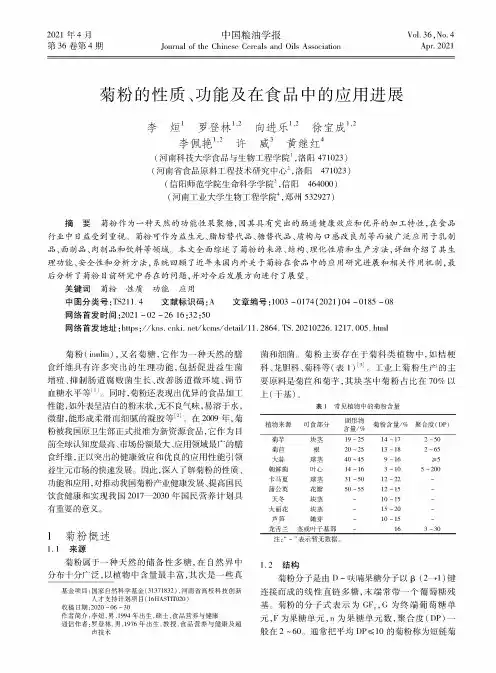
Vol. 36 ,No.4Apr. 20212021年4月第36卷第4期中国粮油学报Journal of the Chinese Cereals and Oils Association 菊粉的性质、功能及在食品中的应用进展李 q 1罗登林2 向进乐2 徐宝成V李佩艳1,2许威3黄继红4(河南科技大学食品与生物工程学院1,洛阳471023)(河南省食品原料工程技术研究中心2,洛阳471023)( 阳 学 生 科学学 3, 阳 464000)(河南工业大学生物工程学院4,郑州532927)摘要菊粉作为一种天然的功能性果聚糖,因其具有突出的肠道健康效应和优异的加工特性,在食7 行业中日益受到重视。
菊粉可作为益生元、脂肪替代7、糖替代7、质构与口感改良剂等而被广泛应用于乳制7、面制7、肉制7和饮料等领域。
本文全面综述了菊粉的来源、结构、理化性质和生产方法,详细介绍了其生理功能、安全性和分析方法,系统回顾了近年来国内外关于菊粉在食7中的应用研究进展和相关作用机制,最后分析了菊粉目前研究中存在的问题,并对今后发展方向进行了展望。
关键词菊粉性质功能应用中图分类号:TS211.4文献标识码:A 文章编号:1003 -0174(2021)04 -0185 -08网络首发时间:2021 -02 -26 16 :32 :50网络首发地址:https ://kns. cnki. net/kcms/detail/11.2864. TS. 20210226. 1217.005. html菊粉(inulin ),又名菊糖,它作为一种天然的膳食纤维具有许多突出的生理功能,包括促进益生菌 增殖、抑制肠道腐败菌生长、改善肠道微环境、调节 血糖水平等[]。
同时,菊粉还表现出优异的食品加工性能,如外表呈洁白的粉末状,无不良气味,易溶于水, 微甜男总形成柔滑而细腻的凝胶等[2]。
在2009年,菊粉被我国原卫生部正式批准为新资源食品,它作为目 前全球认知度最高、市场份额最大、应用领域最广的膳食纤维,正以突出的健康效应和优良的应用性能引领 益生元市场的快速发展。
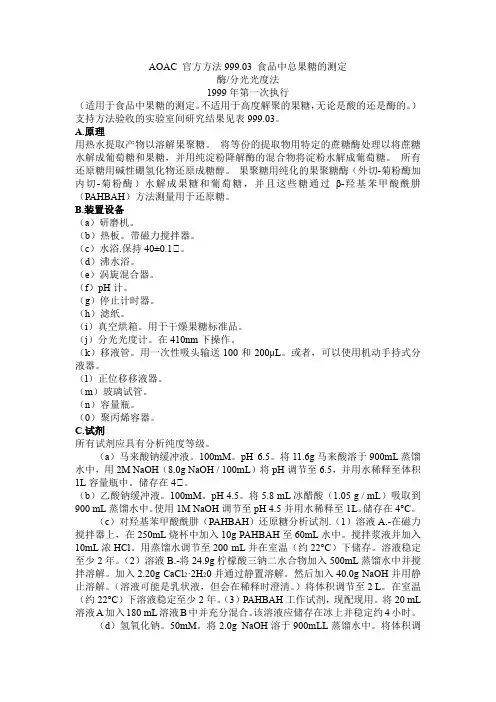
AOAC 官方方法999.03 食品中总果糖的测定酶/分光光度法1999年第一次执行(适用于食品中果糖的测定。
不适用于高度解聚的果糖,无论是酸的还是酶的。
)支持方法验收的实验室间研究结果见表999.03。
A.原理用热水提取产物以溶解果聚糖。
将等份的提取物用特定的蔗糖酶处理以将蔗糖水解成葡萄糖和果糖,并用纯淀粉降解酶的混合物将淀粉水解成葡萄糖。
所有还原糖用碱性硼氢化物还原成糖醇。
果聚糖用纯化的果聚糖酶(外切-菊粉酶加内切-菊粉酶)水解成果糖和葡萄糖,并且这些糖通过β-羟基苯甲酸酰肼(PAHBAH)方法测量用于还原糖。
B.装置设备(a)研磨机。
(b)热板。
带磁力搅拌器。
(c)水浴.保持40±0.1℃。
(d)沸水浴。
(e)涡旋混合器。
(f)pH计。
(g)停止计时器。
(h)滤纸。
(i)真空烘箱。
用于干燥果糖标准品。
(j)分光光度计。
在410nm下操作。
(k)移液管。
用一次性吸头输送100和200μL。
或者,可以使用机动手持式分液器。
(l)正位移移液器。
(m)玻璃试管。
(n)容量瓶。
(0)聚丙烯容器。
C.试剂所有试剂应具有分析纯度等级。
(a)马来酸钠缓冲液。
100mM。
pH 6.5。
将11.6g马来酸溶于900mL蒸馏水中,用2M NaOH(8.0g NaOH / 100mL)将pH调节至6.5,并用水稀释至体积1L容量瓶中。
储存在4℃。
(b)乙酸钠缓冲液。
100mM。
pH 4.5。
将5.8 mL冰醋酸(1.05 g / mL)吸取到900 mL蒸馏水中。
使用1M NaOH调节至pH 4.5并用水稀释至1L。
储存在4°C。
(c)对羟基苯甲酸酰肼(PAHBAH)还原糖分析试剂.(1)溶液A.-在磁力搅拌器上,在250mL烧杯中加入10g PAHBAH至60mL水中。
搅拌浆液并加入10mL浓HCl。
用蒸馏水调节至200 mL并在室温(约22°C)下储存。
溶液稳定至少2年。
(2)溶液B.-将24.9g柠檬酸三钠二水合物加入500mL蒸馏水中并搅拌溶解。
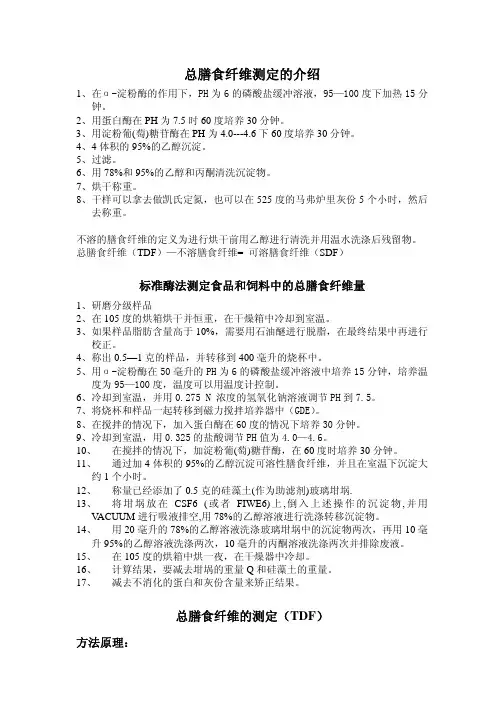
总膳食纤维测定的介绍1、在α-淀粉酶的作用下,PH为6的磷酸盐缓冲溶液,95—100度下加热15分钟。
2、用蛋白酶在PH为7.5时60度培养30分钟。
3、用淀粉葡(萄)糖苷酶在PH为4.0---4.6下60度培养30分钟。
4、4体积的95%的乙醇沉淀。
5、过滤。
6、用78%和95%的乙醇和丙酮清洗沉淀物。
7、烘干称重。
8、干样可以拿去做凯氏定氮,也可以在525度的马弗炉里灰份5个小时,然后去称重。
不溶的膳食纤维的定义为进行烘干前用乙醇进行清洗并用温水洗涤后残留物。
总膳食纤维(TDF)—不溶膳食纤维= 可溶膳食纤维(SDF)标准酶法测定食品和饲料中的总膳食纤维量1、研磨分级样品2、在105度的烘箱烘干并恒重,在干燥箱中冷却到室温。
3、如果样品脂肪含量高于10%,需要用石油醚进行脱脂,在最终结果中再进行校正。
4、称出0.5—1克的样品,并转移到400毫升的烧杯中。
5、用α-淀粉酶在50毫升的PH为6的磷酸盐缓冲溶液中培养15分钟,培养温度为95—100度,温度可以用温度计控制。
6、冷却到室温,并用0.275 N 浓度的氢氧化钠溶液调节PH到7.5。
7、将烧杯和样品一起转移到磁力搅拌培养器中(GDE)。
8、在搅拌的情况下,加入蛋白酶在60度的情况下培养30分钟。
9、冷却到室温,用0.325的盐酸调节PH值为4.0—4.6。
10、在搅拌的情况下,加淀粉葡(萄)糖苷酶,在60度时培养30分钟。
11、通过加4体积的95%的乙醇沉淀可溶性膳食纤维,并且在室温下沉淀大约1个小时。
12、称量已经添加了0.5克的硅藻土(作为助滤剂)玻璃坩埚.13、将坩埚放在CSF6 (或者FIWE6)上,倒入上述操作的沉淀物,并用V ACUUM进行吸液排空,用78%的乙醇溶液进行洗涤转移沉淀物。
14、用20毫升的78%的乙醇溶液洗涤玻璃坩埚中的沉淀物两次,再用10毫升95%的乙醇溶液洗涤两次,10毫升的丙酮溶液洗涤两次并排除废液。
![AOAC_2000[1].11_Polydextrose_in_Foods(食品中聚葡萄糖的测定)](https://uimg.taocdn.com/8f28a1b3fd0a79563c1e72f6.webp)
45.4.06CAOAC Official Method2000.11Polydextrose in FoodsIon ChromotographyFirst Action2000[Applicable to the determination of2–95%(w/w)polydextrose in foods.]See Table2000.11A for the results of the interlaboratory study supporting acceptance of the method.A.PrinciplePolydextrose is extracted from food with hot water and centri-fuged.The supernatant passes through a centrifugal ultrafilter to re-move high molecular weight interferences.The filtrate is treated with an enzyme mixture(isoamylase,amyloglucosidase,and fructanase)to remove any oligosaccharide interferences,mainly malto-oligomers and fructans.Polydextrose standards undergo the same treatment.High-pressure anion exchange chromatography with electrochemical detection(HPAEC–ED)is used to quantitate a high molecular weight fraction of polydextrose.This polydextrose method can be used as an adjunct to the current AOAC methods for measuring total dietary fiber.B.Apparatus(a)Water baths.—Set at80±2°C(increased to boiling);and50±2°C.(b)High speed centrifuge and rotors.—6000×g,preferably up to38000×g with50mL(holds ca38mL)centrifuge tubes;9200×g with1.7mL microcentrifuge tubes;and6400×g with15mL centri-fuge tubes,e.g.,Beckman(Beckman Coulter,Inc.,4300N Harbor Blvd,PO Box3100,Fullerton,CA92834-3100,USA)J2-21centri-fuge with JA-17,JA18.1,and JA-25.15rotors,or equivalent.(c)Analytical balance.—0.1mg accuracy.(d)Bottles and tubes.—Containers with screw caps(250mL), withstanding80°C water.Centrifuge tubes50mL(holds ca38mL), withstanding38000×g(e.g.,Nalgene),and microcentrifuge tubes(1.7mL),withstanding10000×g.(e)Vortex mixer.(f)Pipets.—Adjustable pipet,20–200and200–1000µL.(g)Filters.—PTFE syringe filter,0.2µm pore size,13mm diam-eter.(h)Centrifugal ultrafiltration devices.—100000NMWL(nom-inal molecular weight limit)polyethersulfone membrane,2mL ca-pacity, e.g.,Millipore(Bedford,MA)Ultrafree-CL PBHK BIOMAX-100,or equivalent.(i)High-performance anion-exchange chromatograph (HPAEC–ED).—LC capable of producing ca3000psi(200bar); gradient pump(capable of handling NaOH eluents),and pulsed inte-grated electrochemical detector(with gold electrode),e.g.,Dionex Corp.(PO Box3603,Sunnyvale,CA94088-3603,USA)DX500 basic gradient carbohydrate system,or equivalent.See Ta-ble2000.11B for detector voltage settings for Dionex ED40. (j)LC column.—Microporous substrate(10µm)agglomerated with microbead quaternary ammonium functionalized latex,250×4mm column[e.g.,CarboPak PA1(Dionex,or equivalent)]with guard column(e.g.,CarboPak PA1Guard,23×3mm,or equivalent).C.Reagents(a)Solvents.—Deionized water(resistance≥18M S-cm).(b)Sodium hydroxide.—50%;carbonate free,density1.54kg/L. To100g NaOH,containing≤1%Na2CO3,add100mL H2O.Stop-per and swirl until solution is complete.Let stand until Na2CO3has settled,leaving clear liquid(about10days).Keep tightly closed when not in use.(c)Acetic acid.—0.2M.Dilute1.20g acetic acid to100mL with water.(d)Sodium acetate solution.—0.2M.Dissolve2.72g Na ace-tate⋅3H2O in water and dilute to100mL.(e)Acetate buffer.—pH4.5.Mix28mL acetic acid,(c),with 22mL sodium acetate,(d),and dilute to100mL with water.(f)Fructanase(exo-inulinase).—667U/mL.Contents of bottle (8000U)dissolved in12mL acetate buffer,(e).One unit (Megazyme International Ireland Ltd.,Bray Business Park,Bray, Co.Wicklow,Republic of Ireland,or equivalent)is amount of en-zyme required to release1µmol fructose reducing sugar equivalents from kestose per minute under standard assay conditions(10mM kestose,pH4.5,40°C).Fructanase contains approximately1% endo-inulinase.(g)Amyloglucosidase.—3260U/mL(soluble starch),200U/mL (p-NP-β-maltoside).One unit(soluble starch)is amount of enzyme required to release1µmol glucose from starch per minute under stan-dard assay conditions(starch substrate;10mg/mL starch,pH4.5, 40°C).One unit(p-NP-β-maltoside)is amount of enzyme required to release1µmol p-nitrophenol(pNP)from p-nitrophenol-β-maltoside (in presence of excess-β-glucosidase)per minute under standard as-say conditions(10mM p-NP-β-maltoside,pH4.5,40°C);Megazyme E-AMGDF,or equivalent.(h)Isoamylase.—200U/mL.(Megazyme E-ISAMY,or equiva-lent.)One unit is amount of enzyme required to release1µmol glu-Table2000.11A.Interlaboratory study results for polydextrose in foods by ion chromatographyTest sample0,%No.of labs a(b)s r RSD r,%s R RSD R,%HORRAT Rec.,% Milk chocolate candy19.878 1.10 5.52 2.0110.11 4.099.4 Iced tea 1.8680.12 6.370.2010.70 2.993.0 Sugar cookie8.117(1)0.41 5.100.8610.64 3.681.1 Grape jelly 5.147(1)0.469.040.7214.06 4.5102.8 Polydextrose92.578 3.64 3.93 4.15 4.48 2.292.6 Soft jellied candy33.148 2.557.71 3.5810.81 4.687.2 Powdered drink mix 1.847(1)0.147.710.189.88 2.792.0 a(b)a=Number of collaborating laboratories retained after outliers were eliminated;(b)=number of outlier laboratories.cose reducing sugar equivalents from oyster glycogen per minute under standard assay conditions(10mg/mL oyster glycogen, pH3.5,40°C).(i)Buffered enzyme mix.—Combine fructanase(f;2mL,1324 U),amyloglucosidase(g;84µL,274U),and isoamylase(h;84µL, 16.8U).Dilute in acetate buffer,(e),to20mL.Prepare fresh each day,and store at4°C.(j)Mobile phase A.—0.15M NaOH.Dilute8.10mL50%NaOH, b,to1L with degassed water and store under inert gas.(k)Mobile phase B.—0.15M NaOH and0.5M sodium acetate. Dissolve41.015g sodium acetate(68.04g3H2O)in1L0.15M NaOH.Degas mobile phases before use and store under inert gas. See Table2000.11C for eluent gradient program at flow rate of1.2mL/min.D.Preparation of Standards(a)Polydextrose.—FCC grade;moisture content determined by the Karl Fischer method.Available from Danisco Cultor(440Saw Mill River Rd,Ardsley,NY10502,USA).(b)Polydextrose stock standard solution.—5000mg/L.(Direc-tions are for Dionex DX500system;other systems may require a different range.)Weigh500mg polydextrose(accurate to10mg) into preweighed screw cap glass container,B(d).Add ca100g wa-ter,preheated to80°C,cap tightly,and vortex30s.Place container in 80°C water bath for10min,and vortex for30s at5and10min to solubilize the polydextrose.Remove container from water bath,let cool to room temperature,and reweigh.(c)Intermediate standards.—Serially dilute5000mg/L stan-dard,(b),to make2500,2000,1500,1250,1000,750,500,and 250mg/L polydextrose standards in water.These standards will be diluted5-fold during procedure described in section F and are con-sidered the working standards(500,400,300,250,200,150,100, and50mg/L polydextrose).An8-point calibration curve should give a polynomial regression with a correlation coefficient≥0.995. Stability.—Standards are stable at4°C for1month.E.Preparation of Test SolutionGrind or cut food into small particles.Store in sealed containers to prevent moisture changes.If approximate amount of polydextrose in food is known,weigh quantity of food to yield amount of polydextrose within range of the calibration curve.If amount of polydextrose in the food is not known,estimate amount of polydextrose and choose a test portion weight based on that estimate.Extraction of polydextrose from food.—Weigh appropriate amount of food test sample(accurate to10mg)and add to preweighed container,B(d),with screw cap.Add ca100g hot water preheated to80°C,and immediately replace cap tightly.Vortex mix for30s to disperse food.Place container in water bath at80°C for 10min and vortex mix for30s at5and10min to solubilize the polydextrose.Remove container from water bath,let cool to room temperature,and reweigh.Record total weight,g,and calculate weight,g,of water.Transfer ca25g aliquot into a35mL centrifuge tube,B(b).Centrifuge mixture38000×g for10min to separate sol-ids from supernatant.F.Treatment of Polydextrose Standards and FoodTake2mL aliquot of polydextrose intermediate standard,D(c),or 2mL aliquot of supernatant from E(freeze remaining solution for possible concentration adjustment).Transfer into centrifugal ultrafiltration device,B(h).Centrifuge at5000×g(6400rpm)for 45min.Record weight to0.1mg of1.7mL microcentrifuge tube, B(b).Take0.2mL aliquot of ultrafiltrate,place in the weighed tube and record weight to0.1mg.Add0.8mL buffered enzyme mix,C(i). Record final weight to0.1mg.Calculate weight of0.2mL aliquot and weight of0.8mL buffer enzyme mix.Secure cap and Vortex mix thoroughly.Incubate at50°C for60min.Then place in boiling water bath for10min to denature enzymes.Cool in ice bath or freezer until enzyme precipitates(ca5min in ice).Centrifuge at 9200×g(10000rpm)e supernatant within72h of preparation.G.DeterminationFilter supernatant from F through0.2µm syringe filter,B(g),into autosampler vial.Inject25µL through HPAEC.Analyze each test supernatant in triplicate and determine mean detector response.De-termine peak area for high molecular weight component of polydextrose at retention time ca12min;RSD should be≤5%.If not, repeat HPAEC pare this area with that of the calibra-tion curve.The polydextrose concentration should be in range of the calibration curve.If it is not,rerun the assay,adjusting concentration of initial test sample supernatant(E).H.Calculations(1)Stock standard concentration(µg/g):Stock standard,µg/g=mg polydextrose(dry basis)g water×1000where1000is the conversion factor of mg toµg.(2)Working standard concentration(µg/g):Working standard,µg/g=AA Aintermediate stock concentration112×Table2000.11B.Detector voltage settingsTime(s)Potential(V)integration0.000.050.200.05Begin0.400.05End0.410.750.600.750.61–0.151.00–0.15Table2000.11C.Gradient elution for HPAEC–PAD analysisTime,min Mobile phase A,%Mobile phase B,%00:00703010:00010015:00703020:00Endwhere A1=weight of aliquot(0.2mL)of intermediate standard,g; A2=weight of aliquot(0.8mL)of buffered enzyme mix,g. (3)Polydextrose(%polydextrose)determination:%Polydextrose=PA AAF WF121×××00001.where P=polydextrose concentration(µg/g),obtained from the cal-ibration curve–second order polynomial fit;F=weight of food,g;W=weight of water,g;A1=weight of aliquot(0.2mL)of dilutedfood,g;A2=weight of aliquot(0.8mL)of buffered enzyme mix,g.The0.0001is the conversion factor fromµg/g to%.Reference:J.AOAC Int.84,472(2001).。
AOAC 997.08 食物中果聚糖的测定离子交换色谱法(适用于加工食品中果聚糖添加量的定量分析)附表997.08A 是为支持本方法的建立而进行的多实验室研究结果。
A. 原理用热水提取样品中的果聚糖。
提取液用冻干的淀粉葡萄糖苷酶进行水解处理将淀粉类物质分解。
部分水解液经菊粉酶进一步水解后,测定其中的糖分含量。
用带有脉冲安培检测器的高效阴离子交换色谱仪(HPAEC-PAD )对初始提取液、一次和二次水解液分别进行测定分析。
在糖分测定1中,测出初始提取液中的游离果糖和游离蔗糖的含量;在糖分测定2中,测出一次水解液中游离葡萄糖以及由麦芽糊精和淀粉分解生成的葡萄糖的总量;在糖分测定3中,测出初始提取液经两次水解后的葡萄糖和果糖的含量。
通过对葡萄糖和果糖浓度的计算得出果聚糖的含量。
B. 仪器(a) 阴离子交换色谱仪(HPAEC ):液相色谱梯度泵(带淋洗液脱气装置);微量进样阀;脉冲电化学检测器,脉冲安培检测模式(PAD ),或等效仪器;自动进样器。
HPAEC 参数:柱温40±0.5℃;流速1.0mL/min ;进样量50µL ;检测器灵敏度,模拟量1-3µC 。
流动相梯度见附表997.08B ,检测器时间程序见附表997.08C 。
(b) 高效阴离子交换色谱柱:250 x 4 mm id ,带阴离子交换树脂薄膜及类似保护柱(50 x 4 mm id )。
(c) 数据积分器:Carbopac PA1 (d) 分析天平:精确度0.1 mg (e) 膜过滤器:孔径0.2 µm (f) 柱温箱:温度保持40 ± 0.5℃ (g) 真空烘箱:温度保持55 ± 3℃ (h) 反应管:15 mL ,带螺帽(i) pH 计:温度补偿式,以pH 4.0、7.0和9.0缓冲溶液标准化。
(j) 玻璃微纤维滤膜:截留0.7µm 颗粒。
(k) 过滤架:直径25 mm ,低压注射,或等效仪器。
AOAC饲料中药物官方分析法(2000)第5章40页2000AOAC国际版5.3.02杆菌肽预混剂AOAC官方分析方法杯碟法(本法应用于含≥10g杆菌肽/454g的预混剂)A原理:杆菌肽从已酸化有机溶剂系统中的饲料提取。
提取物离心,上清液用磷酸盐缓冲液稀释,然后用杯碟法用藤黄微球菌检定菌分析。
B试剂与装置(a)微生物—藤黄微球菌ATCC号10240 培养基(见)(b)提取溶剂—混合溶剂,27%乙腈(H3CN),27%甲醇,3%pH6.0的磷酸盐缓冲剂(见),41%水和2%磷酸(85%),加入0.5gEDTA/L(提取溶剂用EDTA饱和的)(c)磷酸盐缓冲剂—5%,pH6.5,见957.23B(d)C(见)(d)稀释剂—甲醇—5%pH6.5磷酸盐缓冲剂(12+88)(e)稀盐酸—小心加89ml盐酸至适量水中,并稀释到1L(1M)。
进一步稀释溶液1﹕100(0.01M)。
(f)钢管见957.23 C (a) (见)(g)钢管分布器:随机的见957.23(d) (见)C标准液见957.24*(a)和(b)(见)。
也即制备0.3和0.16u/ml溶液以平皿作成供试样品,用于监测定量用。
D杯碟准备采用1个约15ml的琼脂抗生素培养基1,957.23A(a)(见)。
通过实验皿最适的浓度(通常为0.02—0.05%)的藤黄微球菌ATCC No 1024,加到琼脂培养基上,使获得抑菌圈为15-17mm,用于0.2u/ml杆菌肽。
注入4个钢管内,标准曲线上的每点(即16个杯点),另外,4个杯为供试液。
标准曲线与杯碟两次(即32个钢圈),将作为检查样品0.3、0.16u/ml。
因此,总的将需要48个杯、两个曲线,对于每个预混剂样品加4个附加杯。
使琼脂培养基铺平,保持水平和一定硬度。
使用前转移到冰箱中,冷却≥1小时,所用碟当天配制。
E 提取准确称取含有约4600单位的杆菌肽饲料量装到300ml 的容量瓶中,或相当的容量瓶,用100ml 移液管加100ml 的提取溶剂,用振荡器振摇,提取饲料≥5分钟,转移上清液到塑料离心管中,2000转/分离心10分钟,通过玻璃棉过滤上清液至刻度量器中,稀释到制取的终稀释度为0.2±0.05u/ml 。
45.4.06BAOAC Official Method999.03Measurement of Total Fructan in FoodsEnzymatic/Spectrophotometric MethodFirst Action1999(Applicable to the determination of fructan in foods.Not applicable to highly depolymerized fructose,either acid or enzymatic.)See Table999.03for the results of the interlaboratory study sup-porting acceptance of the method.A.PrincipleProducts are extracted with hot water to dissolve fructan.Aliquots of extract are treated with a specific sucrase to hydrolyze sucrose to glucose and fructose,and with a mixture of pure starch-degrading enzymes to hydrolyze starch to glucose.All reducing sugars are re-duced to sugar alcohols with alkaline borohydride.The fructan is hy-drolyzed to fructose and glucose with purified fructanase (exo-inulinase plus endo-inulinase),and these sugars are measured by the p-hydroxybenzoic acid hydrazide(PAHBAH)method for re-ducing-sugars.B.Apparatus(a)Grinding mill.—Centrifugal,with12-tooth rotor and0.5mm sieve,or similar device.Alternatively,cyclone mill may be used for small laboratory samples.(b)Hot plate.—With magnetic stirrer.(c)Water bath.—Maintaining40±0.1°C.(d)Boiling water bath.—Deep-fat fryer filled with water at 95–100°C.(e)Vortex mixer.(f)pH Meter.(g)Stop-clock timer.(h)Filter paper.—Fast,e.g.,Whatman No.1,or equivalent.(i)Vacuum oven.—For drying fructose standard.(j)Spectrophotometer.—Operating at410nm.(k)Pipets.—Delivering100and200µL with disposable tips.Al-ternatively,motorized hand-held dispenser may be used.(l)Positive displacement pipetter.—With tips accurately deliv-ering100and200µL,and5.0mL.(m)Glass test tubes.—16×120mm,round bottom,17mL. (n)Volumetric flasks.—50and100mL.(o)Polypropylene containers.—10mL with screw cap.C.ReagentsAll reagents should be of analytical purity grade.(a)Sodium maleate buffer.—100mM,pH6.5.Dissolve11.6g maleic acid in900mL distilled water and adjust pH to6.5with2M NaOH(8.0g NaOH/100mL)and dilute to volume in1L volumetric flask with water.Store at4°C.(b)Sodium acetate buffer.—100mM,pH4.5.Pipet5.8mL gla-cial acetic acid(1.05g/mL)into900mL distilled water.Adjust to pH4.5using1M NaOH and dilute to1L with water.Store at4°C.(c)p-Hydroxybenzoic acid hydrazide(PAHBAH)reducing sugar assay reagent.—(1)Solution A.—Add10g PAHBAH(e.g., Sigma Cat.No.H-9882,Sigma Chemical Co.,PO Box14508,St. Louis,MO63178,USA)to60mL water in250mL beaker on mag-netic stirrer.Stir slurry and add10mL concentrated HCl.Adjust to 200mL with distilled water and store at room temperature(ca22°C). Solution is stable for at least2years.(2)Solution B.—Add24.9g trisodium citrate dihydrate to500mL distilled water and stir to dis-solve.Add2.20g CaCl2⋅2H2O and dissolve by stirring.Then add 40.0g NaOH and dissolve with stirring.(Solution may be milky,but will clarify on dilution.)Adjust volume to2L.The solution is stable for at least2years at room temperature(ca22°C).(3)PAHBAH working reagent.—Immediately before use,add20mL Solution A to180mL Solution B and mix thoroughly.This solution should be stored on ice and is stable for ca4h.(d)Sodium hydroxide.—50mM.Dissolve2.0g NaOH in 900mL distilled water.Adjust volume to1L.Store at room temper-ature(ca22°C).(e)Alkaline borohydride.—Accurately weigh50mg sodium borohydride(Sigma Cat.No.S-9125)into polypropylene containers (10mL volume with screw cap).Record weight on tubes(ca10for convenience);seal tubes and store in a desiccator for future use.Im-mediately before use,dissolve sodium borohydride(at10mg/mL)in 50mM NaOH solution,C(d).This solution is stable for4–5h at room temperature.(f)Acetic acid.—100mM.Add5.8mL glacial acetic acid to dis-tilled water and adjust volume to1L.Store at room temperature(ca 22°C).(g)Sucrase/amylase preparation.—2.27units(U)sucrase/mL. Dissolve contents of1vial containing sucrase(50U)plusβ-amylase (Bacillus cereus,500U),pullulanase(Bacillus licheniformis, 100U),and maltase(yeast,1000U)(as a freeze-dried powder)in 22mL sodium maleate buffer,C(a).Divide enzyme solution into 5mL aliquots,and store frozen in polypropylene containers to pre-Table999.03Interlaboratory study results of total fructan in food products and plant materials as g/100g materialMaterial bs No.outliers Mean RSD r,%RSD R,%r R Chocolate13013.52 6.49.9 2.4 3.7 Milk powder13010.64 6.710.4 2.0 3.1 Vitamin tablet130 4.607.19.90.9 1.3 Onion10351.43 4.7 6.2 6.88.9 Fructan control13028.47 6.68.7 5.37.0 Pure fructan10295.87 2.8 5.07.413.3 Wheat stalks130 4.72 2.38.60.3 1.1 Jerusalem artichoke11251.63 4.7 5.7 6.88.3 Low fat spread1308.197.310.8 1.7 2.5vent microbial contamination.If not diluted in buffer,the freeze-dried enzyme is stable5years when stored at–20°C.One unit sucrase activity is the amount of enzyme required to release1µmole glucose/min from sucrose at pH6.5and40E C.(h)Fructanase solution.—350U/mL exo-inulinase and35U/mL endo-inulinase.Dissolve contents of1vial containing8000U exo-inulinase and800U endo-inulinase in22mL sodium acetate buffer,C(b).Divide enzyme solution into5mL aliquots and store frozen in polypropylene containers to prevent microbial contamina-tion.If not diluted in buffer,the freeze-dried enzyme is stable5years when stored at–20°C.One unit(U)exo-inulinase activity is the amount of enzyme required to release1µmole of reducing-sugar equivalents(as fructose)/min from kestose(10mg/mL)at pH4.5 and40E C.(i)Fructan control flour.—Containing a known amount of dahlia fructan freeze-dried in the presence ofα-cellulose.Stable when stored dry at room temperature.(j)Sucrose control flour.—Sucrose freeze-dried in the presence ofα-cellulose.Stable when stored dry at room temperature(ca 22°C).(k)D-Fructose standard stock solution.—1.5mg/mL in0.2% benzoic acid solution.Before preparing solution,dry powdered crystalline fructose(purity>97%)16h at60°C under vacuum. Items(g)–(k)are supplied in the Fructan Assay Kit available from Megazyme International Ireland Ltd.,Bray Business Park,Bray, County Wicklow,Ireland,but preparations of enzymes and stan-dards which meet these criteria may also be used.D.Preparation of Test MaterialsAll products should be at room temperature(22°C)before they are weighed.(a)Test samples.—For dry food,grind ca50g laboratory sample in grinding mill to pass0.5mm sieve.Transfer all material into wide-mouthed plastic jar and mix well by shaking and inversion. For solid moist products such as chocolate,warm to room temper-ature(ca22°C)and grate the material with a cheese grater.For soft,very moist foods such as low-fat spreads,warm material until it is soft;then stir vigorously with a spatula and take a portion representing the bulk material.For liquids or semi-liquid products such as juices or yogurt,adjust pH to ca6.5before heating.These products can be directly diluted in the maleate buffer,C(a).(b)Fructose standard working solution.—Add0.2mL fructose standard stock solution[1.5mg/mL,C(k)]to0.9mL acetate buffer, C(b),and mix thoroughly.Dispense0.2mL aliquots of this solution (containing54.5µg fructose)in quadruplicate to the bottoms of 4glass test tubes,B(m).Add0.1mL acetate buffer,C(b),to each tube.Immediately before incubation in boiling water bath,add5.0mL PAHBAH working reagent,C(c).(c)Reagent blank.—Transfer0.3mL acetate buffer,C(b),into test tubes and proceed with the standard assay procedure from E(c)(3).(d)Sucrose control powder.—Containing ca10%sucrose.Ana-lyze1.0g of this powder by the same procedure as used for test mate-rials containing0–12%fructan.This product contains no fructan and is used to check the effectiveness of the sucrase and borohydride treatments.The calculated fructan content should be no more than 0.3%.E.Determination(a)Extraction of fructan.—(1)Products containing0–12% fructan.—Run D-fructose working standard solution(in quadrupli-cate),reagent blank(in duplicate),fructan control flour,and sucrose control flour with each set of e reagent blank to zero the spectrophotometer.(i)Accurately weigh1.0g test portion into dry200mL Pyrex beaker.Add80mL hot distilled water at∼80°C;stir and heat beaker and contents on a hot-plate with a magnetic stirrer at∼80°C for ca 15min until solids are completely dispersed.pH of solution or slurry is>5.5,or fructan may be partially depolymerized.(ii)Cool solution to room temperature,quantitatively transfer to 100mL volumetric flask,adjust volume to mark with distilled water, and mix.(iii)Filter aliquot of solution through paper,B(h),and analyze immediately.Filtrate may be slightly turbid.This is not a problem. (If filtrate is stored for several hours at low temperature before anal-ysis,the fructan may precipitate from solution.In such cases,reheat solution to~80°C and let cool to room temperature before removing solutions for analysis.)(2)Products containing12–50%fructan.—Run D-fructose working standard solution(in quadruplicate),reagent blank(in du-plicate),fructan control flour,and sucrose control flour with each set of e reagent blank to zero the spectrophotometer.(i)Accurately weigh90–100mg ground test portion directly into dry100mL Pyrex beaker.Add40mL hot distilled water at~80°C, stir and heat beaker and contents on hot-plate with a magnetic stirrer at~80°C for ca15min until the solids are completely dispersed.pH of solution or slurry is>5.5,or fructan may be partially depolymerized.(ii)Cool solution to room temperature,quantitatively transfer to 50mL volumetric flask,adjust volume to mark with distilled water, and mix contents thoroughly.Filter an aliquot of solution into reac-tion tube,B(h)and analyze immediately.(3)Products containing50–100%fructan.—Proceed as in(2), but transfer solution to100mL volumetric flask and adjust to mark.Filter an aliquot of solution through paper,B(h),and ana-lyze immediately.(b)Removal of sucrose,starch,and reducing sug-ars.—(1)Transfer0.2mL filtrate to be analyzed(containing ca 0.1–1.0mg/mL fructan,or controls)to bottoms of2glass test tubes, B(m).(2)Add0.2mL diluted sucrase/amylase solution,C(g),to each tube and incubate at40°C for30min.(3)Add0.2mL alkaline borohydride solution,C(e),to each tube. Stir tube vigorously and incubate at40°C for30min for complete re-duction of reducing sugars to sugar alcohols.(4)Add0.5mL acetic acid,C(f),to each tube with vigorous stir-ring on Vortex mixer.If borohydride is fresh,a vigorous efferves-cence should be observed.If not,there is a problem with the borohydride;repeat analysis with fresh borohydride.(This treat-ment removes excess borohydride and adjusts pH to ca4.5.)This is Solution A.(c)Hydrolysis and measurement of fructan.—(1)Transfer0.2mL aliquots Solution A(in duplicate)to the bottoms of glass test tubes,B(m).(2)Add0.1mL fructanase solution,C(h),to each test tube,stir contents on Vortex mixer,and incubate at40°C for20min for com-plete hydrolysis of fructan to fructose and glucose.(3)Add 5.0mL PAHBAH working reagent to all tubes,including fructose standard working solution,D (b ),reagent blank,D (c ),and extracts of fructan control sample,C (i ),and sucrose control sample,C (j ),and incubate in boiling water bath for exactly 6min.(4)Remove all tubes from boiling water bath and immediately place in cold water (18–20°C)for ca 5min.(5)Measure absorbance of all solutions at 410nm against reagent blank as soon as possible after cooling.The PAHBAH color com-plex will fade with time.At room temperature,little change (<5%)is seen over 10–15min.The same change will be seen in the standard solutions.F.CalculationsCalculate total fructan content (%,on as-is basis)in test samples as follows:Total fructan,%=A F V W ×××××××5110210011000162180..where A =absorbance of 0.2mL reacted solutions read against re-agent blank;F =factor to convert absorbance values to µg fructose (=54.5µg fructose/absorbance value for 54.5µg fructose);5=fac-tor to convert from 0.2mL as assayed to 1.0mL;V =volume (mL)of extractant used (100or 50mL);1.1/0.2=0.2mL was taken from 1.1mL enzyme digest for analysis;W =weight (mg)of test portion extracted;100/W =factor to express fructan as percentage of flour weight;1/1000=factor to convert from µg to mg;162/180=factor to convert from free fructose,as determined,to anhydrofructose (and anhydroglucose),as occurs in fructan.G.Indicative ControlsIndicative controls are used as a check on assay conditions.The fi-nal absorbance of the sucrose/α-cellulose material should be very low (<0.03),which demonstrates the effectiveness of both the sucrase treatment step and the borohydride reduction step.If sucrose is not completely hydrolyzed by the sucrase treatment,it will then be hydrolyzed by the fructanase mixture and give erroneously high fructan values.Other indicative controls can be used,such as soluble starch and α-cellulose.The absorbance from α-cellulose should be negligible,i.e.,<0.001;for soluble starch,the absorbance should be very low,i.e.,<0.03.This result for starch demonstrates the effec-tiveness of the borohydride reduction step.Reference:J.AOAC Int.83,356(2000).Revised:March 2002。
AOAC_996.06(中文翻译)41.1.28AAOAC 官方方法 996.06食物中的总脂肪、饱和脂肪、不饱和脂肪水解提取气相色谱法1996年首次实施2001年修订(适用于食物中脂肪的检测)注:如果吸入三氟化硼可能是致命的。
A. 原理脂肪和脂肪酸,用水解的方法食品萃取(对于大多数产品用酸性水解,乳制品用碱性水解,奶酪用二者组合)。
在分析过程中,加入焦性没食子酸以最小化脂肪酸氧化降解。
样品中加入内标物十一碳甘油三脂。
脂肪用乙醚提取,然后在甲醇中使用BF3使其甲酯化生成脂肪酸甲酯。
脂肪酸甲酯是由毛细管气相色谱(GC)对内标物C11:0进行定量测定。
依据各种脂肪酸甲酯含量和转换系数计算出总脂肪、饱和脂肪(酸)、单不饱和脂肪(酸)、多不饱和脂肪(酸)含量。
B. 仪器(a) 气相色谱仪(GC)——配有氢火焰离子检测器(FID),毛细管色谱柱,分离式注射器,能以温度调控来操控静止-上升-静止顺序的烘箱。
操作条件:温度(℃):注射器,225;检测,285;初始温度,100(保持4分钟);上升,3摄氏度每分钟;最终温度,240(保持15分钟);运载气体,氦;流速,0.75毫升每分钟;线速度,18厘米每秒;分离率,200:1。
(b) 毛细管色谱柱——以1.0或更高的分离率分离一对相邻的脂肪酸色谱峰(C18:3和C20:1)和三个相邻的色谱峰(C22:1、C22:3和C22:4)。
SP2560 100m×0.25mm,0.20μm。
(c) 莫琼尼尔烧瓶(脂肪萃取瓶)(d) 瓶塞——合成橡胶或软木(e) Mojonnier离心机盘(f) Hengar微沸腾颗粒(g) 篮子——铝或塑料(h) 振荡水浴箱——保持70-80℃(i) 蒸气浴——支持常见的玻璃器皿。
(j) 水浴——氮流,保持40±5℃。
(k) 手动摇筛机——Mojonnier离心机盘配套(l) Mojonnier电驱动离心机——可选;保持600×g。
AOAC 官方方法999.03 食品中总果糖的测定酶/分光光度法1999年第一次执行(适用于食品中果糖的测定。
不适用于高度解聚的果糖,无论是酸的还是酶的。
)支持方法验收的实验室间研究结果见表999.03。
A.原理用热水提取产物以溶解果聚糖。
将等份的提取物用特定的蔗糖酶处理以将蔗糖水解成葡萄糖和果糖,并用纯淀粉降解酶的混合物将淀粉水解成葡萄糖。
所有还原糖用碱性硼氢化物还原成糖醇。
果聚糖用纯化的果聚糖酶(外切-菊粉酶加内切-菊粉酶)水解成果糖和葡萄糖,并且这些糖通过β-羟基苯甲酸酰肼(PAHBAH)方法测量用于还原糖。
B.装置设备(a)研磨机。
(b)热板。
带磁力搅拌器。
(c)水浴.保持40±0.1℃。
(d)沸水浴。
(e)涡旋混合器。
(f)pH计。
(g)停止计时器。
(h)滤纸。
(i)真空烘箱。
用于干燥果糖标准品。
(j)分光光度计。
在410nm下操作。
(k)移液管。
用一次性吸头输送100和200μL。
或者,可以使用机动手持式分液器。
(l)正位移移液器。
(m)玻璃试管。
(n)容量瓶。
(0)聚丙烯容器。
C.试剂所有试剂应具有分析纯度等级。
(a)马来酸钠缓冲液。
100mM。
pH 6.5。
将11.6g马来酸溶于900mL蒸馏水中,用2M NaOH(8.0g NaOH / 100mL)将pH调节至6.5,并用水稀释至体积1L容量瓶中。
储存在4℃。
(b)乙酸钠缓冲液。
100mM。
pH 4.5。
将5.8 mL冰醋酸(1.05 g / mL)吸取到900 mL蒸馏水中。
使用1M NaOH调节至pH 4.5并用水稀释至1L。
储存在4°C。
(c)对羟基苯甲酸酰肼(PAHBAH)还原糖分析试剂.(1)溶液A.-在磁力搅拌器上,在250mL烧杯中加入10g PAHBAH至60mL水中。
搅拌浆液并加入10mL浓HCl。
用蒸馏水调节至200 mL并在室温(约22°C)下储存。
溶液稳定至少2年。
(2)溶液B.-将24.9g柠檬酸三钠二水合物加入500mL蒸馏水中并搅拌溶解。
加入2.20g CaCl2·2H20并通过静置溶解。
然后加入40.0g NaOH并用静止溶解。
(溶液可能是乳状液,但会在稀释时澄清。
)将体积调节至2 L。
在室温(约22°C)下溶液稳定至少2年。
(3)PAHBAH工作试剂,现配现用。
将20 mL 溶液A加入180 mL溶液B中并充分混合。
该溶液应储存在冰上并稳定约4小时。
(d)氢氧化钠。
50mM。
将2.0g NaOH溶于900mLL蒸馏水中。
将体积调节至1 L。
在室温下保存(约22℃)。
(e)碱性硼氢化物.-将50mg硼氢化钠准确称入聚丙烯容器中。
记录管上的重量,密封管并存放在干燥器中以供使用。
使用前即刻。
将硼氢化钠(10mg / mL)溶于50mM NaOH溶液中。
该溶液在室温下稳定4-5小时。
(f)乙酸。
100mM。
将5.8 mL冰醋酸加入蒸馏水中,并将体积调节至1 L。
在室温下(约22°C)储存。
(g)蔗糖酶/淀粉酶制剂。
2.27单位(U)蔗糖酶/毫升。
溶解在1瓶含有蔗糖酶(50 U)和(β-淀粉酶(蜡状芽孢杆菌,500 U),支链淀粉酶(地衣芽孢杆菌,100 U)和麦芽糖酶(酵母.1000 U)(作为冻干粉末)在22mL马来酸钠缓冲液。
C(a)将酶溶液分成5 mL每份,并冷冻储存在聚丙烯容器中以防止微生物污染。
如果不在缓冲液中稀释,则在-20℃下储存时,该灭菌酶可稳定5年。
一个单位蔗糖酶活性是在pH6.5和40℃下从蔗糖释放1微摩尔葡萄糖/分钟所需的酶量。
(h)果聚糖酶溶液。
350U / mL外切-菊粉酶和35U/mL内切-胰岛素酶。
将含有8000U外切-菊粉酶和800U内-缬氨酸酶溶解在装有22mL乙酸钠缓冲液的瓶子中,C(b)。
将酶溶液分成5mL等分试样并冷冻储存在聚丙烯容器中以防止微生物接触。
如果不在缓冲液中稀释,则在-20℃下储存时,干燥的酶可稳定5年。
一个单位(U)外切-菊粉酶活性是在pH4.5和40℃下从半胱氨酸(10mg / mL)释放1μm的还原糖当量(作为果糖)/ min所需的酶量。
(i)果聚糖对照面粉。
含有已知量的在α-纤维素存在下冷冻干燥的dahlia 果聚糖。
在室温下干燥储存时稳定。
(j)蔗糖对照面粉。
在α-纤维素存在下冷冻干燥的蔗糖。
在室温(约22°C)下储存时稳定。
(k)D-果糖标准储备溶液。
1.5mg / mL,在0.2%苯甲酸溶液中。
在制备溶液之前,将干燥的粉状结晶果糖(纯度> 97%)在60℃下进行16小时真空吸尘。
D.测试材料的制备所有产品在称重前应在室温(22℃)下进行。
(a)测试样品。
对于干燥食品,在研磨机中研磨约50g实验室样品以通过0.5mm筛。
将所有材料转移到广口塑料罐中,通过摇动和倒置混合均匀。
对于固体潮湿的产品,如巧克力,温热至室温(约22℃),并用奶酪刨丝器将材料碾碎。
对于软的,非常潮湿的食物,如低脂酱,加热材料直到它变软;然后用抹刀剧烈搅拌,并取一部分代表散样。
对于液体或半液体产品,如果汁或酸奶,在加热前将pH调节至约6.5。
可以直接稀释在马来酸盐缓冲液中,C(a)。
(b)果糖标准工作溶液。
加入0.2 mL果糖标准储备溶液[1.5 mg/mL,C(k)]至0.9mL乙酸盐缓冲液,C(B)。
并彻底混合。
将0.2mL等份的该溶液(含有54.5μg果糖)一式四份分配到4个玻璃试管,B(M)。
加入0.1 mL乙酸盐缓冲液每管,C(b)。
在反应之前立即用沸水浴,加入5.0 mL PAHBAH工作试剂中,C(c)。
(c)试剂空白。
转移0.3mL乙酸盐缓冲液,C(b)。
进入试管并进行E(c)的标准试验。
(d)蔗糖对照面粉。
含有10%蔗糖。
按照与含有0-12%果聚糖的试验材料相同的程序分析1.0 g这种粉末。
本品不含果聚糖,用于检查蔗糖酶和硼氢化钠处理的效果。
计算出的果聚糖含量不应超过0.3%。
E.定量(a)果聚糖的提取。
(1)含有0-12%果聚糖的样品,运行D-果糖工作标准溶液(一式四份),试剂空白(一式两份),果聚糖对照面粉和蔗糖对照面粉各组试验。
利用试剂空白将分光光度计归零。
(i)将1.0g测试部分准确称入干燥的200mL烧杯中。
在~80℃加入80mL 热蒸馏水:搅拌并加热烧杯,用磁力搅拌器在~80℃下加热加热板约15分钟直至固体完全分散。
溶液浆液的pH值> 5.5。
果聚糖可以部分解聚。
(ii)将溶液冷却至室温,定量转移至100mL容量瓶中,用蒸馏水定容至刻度线,并混合。
(iii)通过纸过滤等分的溶液试样,B(h)。
并立即分析。
滤液可能略微混浊。
这不是问题。
(如果滤液在分析前在低温下储存数小时,则可能会沉淀出溶液。
在这种情况下,将溶液再加热至~80°C并冷却至室温,然后取出溶液进行分析。
)(2)含12-50%果聚糖的样品。
运行D-果糖工作标准溶液(一式四份),试剂空白(一式两份)。
果糖对照面粉和蔗糖对照面粉与每组测试样。
使用试剂空白将分光光度计归零。
(i)准确称取90-100 mg磨碎试料,直接放入100 mL耐热玻璃烧杯中。
在〜80°C下加入40毫升热蒸馏水,用〜80°C的磁力搅拌器搅拌烧杯并加热其内容物约15 min,直到固体完全分散。
溶液或浆液的pH值大于5.5,或果聚糖可能部分解聚。
(ii)将溶液冷却至室温,定量转移至50mL容量瓶中,用蒸馏水调节体积,并彻底混合内容物。
将等分试样的溶液过滤到反应管中B(h),并立即分析。
(3)含有50-100%果聚糖的产品。
按照(2)进行,将溶液转移到100mL 容量瓶中并调节至标记。
通过纸张过滤等分的溶液,B(h),并立即分析。
(b)去除蔗糖,淀粉和还原糖。
(1)将0.2mL要分析的滤液(含有约0.1-1.0mg/mL果聚糖及对照样)转移到2个玻璃试管的底部。
B(m)。
(2)加入0.2mL稀释的蔗糖酶/淀粉酶溶液,C(g),到每管,在40℃下反应30分钟。
(3)加入0.2mL碱性硼氢化物溶液,C(e), 到每个管。
剧烈搅拌管,在40℃下反应30分钟,完全还原为糖醇。
(4)加入0.5mL乙酸,C(f), 到每管。
在涡旋混合器上对每个管进行剧烈涡旋。
如果硼氢化物是新鲜的,应该会观察到剧烈的反应。
如果没有,硼氢化物存在问题,改用新鲜的硼氢化物分析。
(此处理可去除过量的硼氢化物并将pH 调节至约4.5。
)。
这是溶液A.(c)果聚糖的水解和测定。
(1)将0.2毫升等份溶液A(一式两份)转移到玻璃试管。
B(m)。
(2)加入0.1毫升果聚糖溶液,C(h),到每个试管中,在涡流搅拌机上搅拌内容物,并在40℃下反应20分钟,使果聚糖完全水解为果糖和葡萄糖。
(3)向所有试管中加入5.0 mL PAHBAH工作试剂,包括果糖标准工作液,D(b),试剂空白,D(c)和果聚糖对照样品C(i)和蔗糖对照样品C(j)的提取物,并在沸水浴中反应恰好6分钟。
(4)从沸水浴中取出所有试管,立即置于冷水(18-20℃)中约5分钟。
(5)冷却后尽快测量410nm处所有溶液对试剂空白的吸光度。
PAHBAH颜色复合物会随着时间的推移而褪色。
在室温下,在10-15分钟内几乎没有变化(<5%)。
标准溶液也会出现同样的变化。
F计算计算总果聚糖含量(%。
如下:式中,A=0.2 ml反应溶液的吸光度相对于试剂空白读取;F=将吸光度值转换为ug果糖的系数(=54.5 ug果糖/54.5 ug果糖的吸光度值);5 =将测定的0.2mL 转化为1.0mL的因子; V =所用提取剂的体积(mL)(100或50mL); 1.1 / 0.2 =从1.1mL酶消化物中取出0.2mL用于分析;W =提取的测试浓度的重量(mg);100 / W =以面粉重量的百分比表示果聚糖的因子;1/1000 =从ug转换为mg的因子;62 / 180 =从游离果糖转化的因子,已测定的脱水葡萄糖(和脱水葡萄糖),是在果聚糖中发生的。
G.指示性控制指示性对照用于检测测定条件。
蔗糖/α-纤维素材料的最终吸光度应非常低(<0.03)。
这证明了蔗糖酶处理步骤和硼氢化物还原步骤的有效性。
如果蔗糖未被蔗糖酶处理完全水解,则其将被果聚糖酶混合物水解并产生错误的高果聚糖值。
可以使用其他指示性对照,例如可溶性淀粉和α-纤维素。
来自α-纤维素的吸光度应该是可忽略的。
即<0.001;对于可溶性淀粉。
吸光度应该是非常低,即<0.03。
淀粉的这一结果证明了硼氢化物还原步骤的有效性。